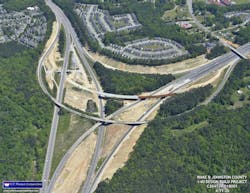Putting the Brakes on Erosion for I-40 Road Construction
About the author:
Matt Davis is project manager with S.T. Wooten.
Moving dirt around is a big component of any construction project, and that’s no different for an I-40 highway widening job in Raleigh. When complete in 2022, there will be two new lanes added in each direction along the busy 13-mile stretch of highway from the I-440/40 Interchange in Raleigh to two miles east of the busy N.C. 42 interchange in Johnston County.
While it might not be the first thing that comes to mind for most, erosion control has played a huge role in the progress with construction and upgrades to the storm drain systems, with a focus on minimizing the impacts of environmentally sensitive areas.
S.T. Wooten grade and erosion control crews keep their eyes on trying to prevent all that dirt from moving to the wrong places.
Maintaining Erosion Control Standards
Being strategic about where to move soil and manage runoff helps ensure that protected areas surrounding I-40 remain just that – protected. It keeps the project compliant with North Carolina Department of Transportation (NCDOT) Erosion Control Standards and the Environmental Permit. These standards have been designed to reduce storm water impact from transportation-related development projects like this one.
The expansive I-40 project always has crews on the move, meaning the erosion control process is constantly ongoing. Once a site is cleared by grading crews, S.T. Wooten’s erosion control team begins work with the installation of a silt fence, safety fence and inlet protection. These components help treat storm water before it runs off the project site, preventing erodible dirt and soil from being carried away into streams, waterways and beyond the project limits.
A lot of the erosion control work on I-40 has been done by hand due to access restrictions across many sites around the work zone. Typically, equipment like excavators can’t be brought through a protected area; thus, the crews manually install silt fences while utilizing hand tools. Teams will also hand-carry five-gallon buckets full of stone in order to place rock where it’s needed.Preventing and Capturing Runoff
One of the biggest tasks for the erosion control crews on the I-40 job has been the installation of basins, which help capture project runoff and treat it before it leaves the project limits. There has been no shortage of these drainage areas required for a project this large and spread out. So far, the team has installed 62 temporary detention basins throughout the work zone.
Most of the temporary installations have consisted of Type B, tiered or skimmer basins. Two of the temporary skimmer basins set up near Swift Creek at the Johnston County line will eventually become permanent ones. Once an area has enough vegetation, roughly 80%, the team can remove the basin and grade the area in its permanent design.
Additionally, S.T. Wooten is placing temporary erosion control devices in areas to help protect them from excess rainwater. The devices are designed to withstand a 10-year peak runoff event, meaning they will protect against water runoff from common rainstorms up to a strong storm that is likely to happen just once in 10 years. However, crews understand that the project has and will continue to face severe storms that can cause the devices to become overwhelmed.
The I-40 project has several ongoing operations, such as excavation, fine grading and storm drainage which has exposure. Heavy rains over freshly graded dirt can accelerate erosion in these areas. These circumstances, combined with those posed by potential damaging storms, make it all the more important to conduct ongoing monitoring and maintenance of the erosion devices.
Crews are prepared to get more hands on when there is a major storm or heavy rains. If sediment runs off the project due to heavy storm water runoff, it will be manually retrieved. All the devices put in place to capture runoff minimize the threat of sediment loss.Making Adjustments
While erosion control can be routine, there are other challenging times during large storm events when normal maintenance issues become more urgent. Monthly inspections done in conjunction with the NCDOT and RK&K Civil Engineering help keep tabs on areas and see if any interim work is necessary to support the project.
Interim phases may not be initially planned from the onset, but they have helped increase efficiency and quality for erosion control efforts on I-40. For example, a monthly erosion control review of one of the temporary runoff sites near the expanding White Oak shopping area in Garner led to some changes to better accommodate storm water. The erosion control crew was brought in to expand the site and allow a higher volume of runoff to flow through from the widened highway as well as from the busy shopping center.
To complete this transition, a smaller bypass drainage pump was removed that had been in place for temporary water diversion and upgraded with a larger pump to help control the water level while the channel improvements could be completed. A haul road was made so the excavator could transport dirt, sheeting and rocks for crews to utilize in expanding the site. In addition to widening the drainage site, the area above was cleared and covered with rip rap along with a new silt fence.
It only took a few days of work to make a major impact. The area was completely transformed within a week and now it is wide enough to double the amount of storm water the site can handle.
Hard Work Pays Off
The S.T. Wooten grading and erosion control crews will continue to be counted on to support this project as the 2022 finish line draws near. Thanks to the hard work from crew members across the board, it’ll mean smoother and safer roads for drivers in North Carolina’s capital city.


